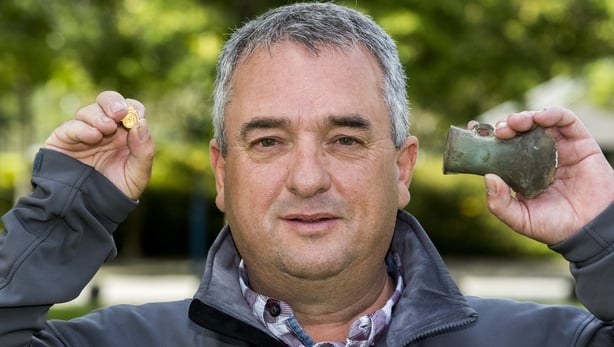A medieval gold seal of a type not seen before by museums across Ireland and Britain is among three items that have been declared treasure at Belfast Coroner's Court.
The tiny artefact was found by local treasure hunter Adrian McStraw while using a metal detector in a field at Derryvullan, Co Fermanagh, on 3 February last.
Around the size of a thumb nail, the piece consists of a double-sided seal which swivels, with a lion and dove set within a shield on one side and a heart pierced by arrows on the other side.
The Co Armagh man said he found the seal around 15 to 18 centimetres below the surface after his metal detector alerted him, adding it was after he walked just six metres after having a cup of tea.
Mr McStraw has found a number of historical artefacts through his hobby over the years, but described the seal as the most significant.
Kim Mawhinney, head of art at National Museums NI, said the seal had been found to be between 20-21 carat gold.
She explained it would have been worn on a chain by a gentleman and used as a seal for letters, before speculating that it may have been dropped during a visit to Derryvullan Church and graveyard.
Ms Mawhinney said it dated to around the 17th century and said the heart detail indicated it may have been given to a gentleman as a love token, adding the other side appeared to be a family coat of arms but that it had not yet been identified.
"I also consulted my colleagues in the British Museum and National Museums Ireland to see if they had an equivalent style of fob, and they did not have anything which would be similar," she said.
Coroner Marie Anderson inspected the item herself, describing it as beautiful before declaring it to be treasure.
Ms Anderson also heard two other treasure trove inquests.
One examined two late Bronze Age axe heads which were also found by Mr McStraw, this time in a field close to Aghagallon, Co Antrim, last February.

The inquest heard they are likely to date to between 950-700BC and that such axes were the most common tools from that period, used for chopping wood, house building, making wooden trackways and furniture.
The final inquest heard about the finding of a Viking age silver arm ring by another treasure hunter, Michael Thompson, in a field close to Ballinderry, Co Antrim, on 24 November 2018.
Mr Thompson, who is from Ballinderry, told the inquest he found it on one of his first outings with the metal detector.
Dr Greer Ramsey, curator of archaeology at National Museums NI, said the piece was found to be 92% silver, likely to date back to the 9th century and was unusual in how it had been found deliberately folded into quarters and flattened with a hammer.
He described this as highly unusual and speculated it may have been for transporting or hiding, revealing that such arm rings were made to specific weights and served as both jewellery and currency.

